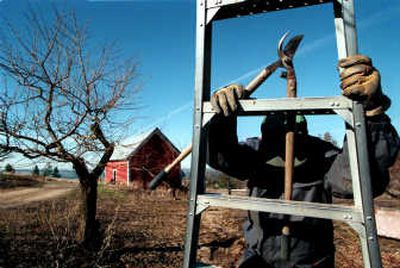Be prepared for winter

I was lucky to get to spend the last two warm days this fall working outside near a Hillyard playfield. In between shoveling dirt into garden boxes, I stopped and just enjoyed the color around me. The trees and shrubs certainly put on a show for us this year. Now is a great time to make sure they will be as pretty next year.
The best way to insure your trees and shrubs perform their best next year is to make sure they go into winter this year well-hydrated. Even though it is time to blow out sprinkler systems, leave a hose out and water your shrubs and trees until the heavy rains come or until you can’t keep the hose thawed. We have had some rain but because it was so hot and dry this year there is little deep soil moisture. We have actually lost more plants that went into winter dry in the last few years than we have to cold.
Most pruning should wait until late winter and early spring. The exception will be spring flowering shrubs that should be pruned after they bloom next spring. Trim them now and it removes the blooms. Pruning other shrubs now leaves all the cuts open to the freezing and thawing over winter. Evergreens that have very upright branches that can bend under a snow load should be spiral wrapped with a biodegradable twine to help hold them together. Remove it in the spring. You can harvest some evergreen cuttings for holiday use without damaging the trees.
Don’t fertilize shrubs and trees now as they can’t use it effectively. Wait until late winter.
Need more color? There is still time to plant container-grown and balled and burlapped trees and shrubs. Some of the nurseries may still have plants available at good prices.
Start by digging a saucer-shaped hole three times the width of the root ball and deep enough to let the root flare at the soil line. The root flare is the point where the trunk flares out to form the roots. Gently remove pots from containerized plants and place them in the hole. Rough up the root ball a bit and untangle any roots winding around the container. Carefully remove all the twine and as much of the burlap as you can from balled and burlapped plants without breaking up the root ball. You may need to dig into the top of the root ball to find the root flare point.
Back fill the hole with native soil and level it at the root flare point. Have the hose running in the hole as you fill it. Mulch the root area to within six inches of the trunk with three inches of compost, bark or shredded leaves and needles and create a basin around the plant. Fill this up a couple of times with water and let it drain. Unless you live in an area that gets hammered with winds, trees do not need to be staked.